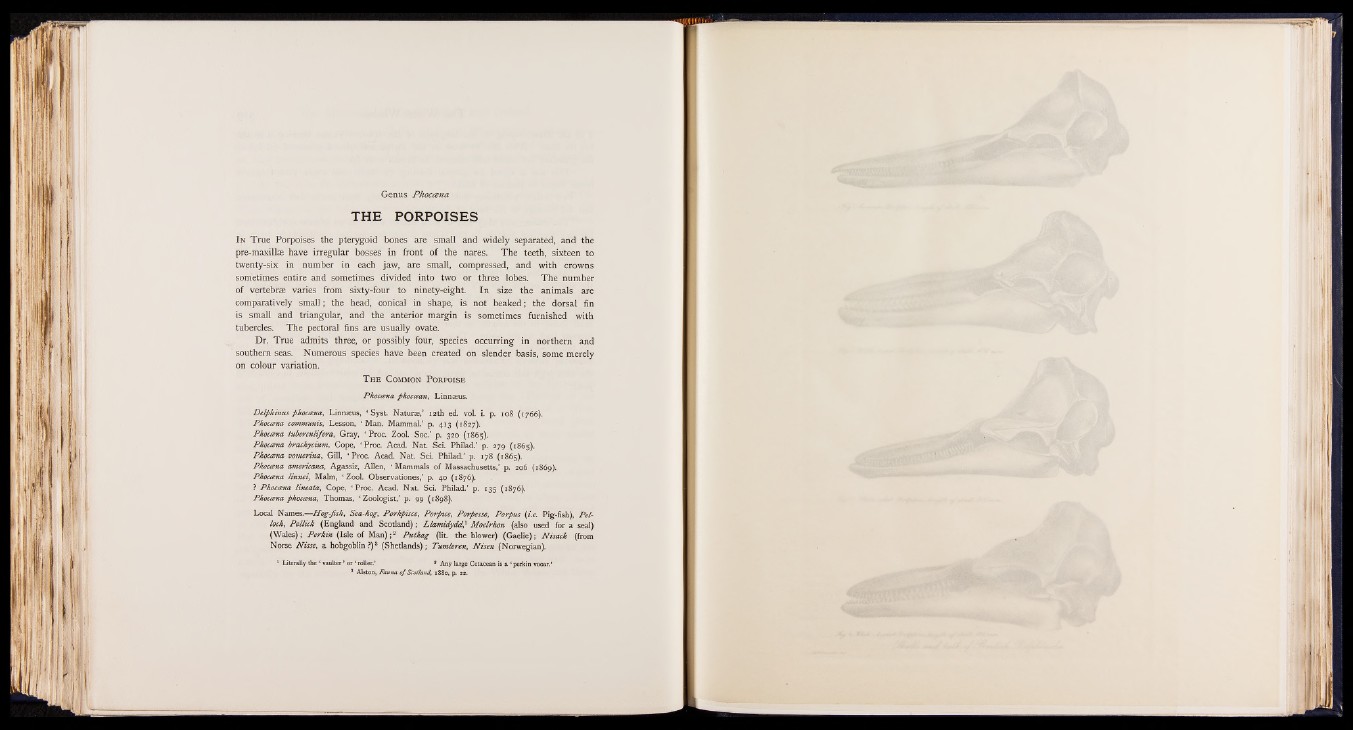
Genus Phocezna
T H E P O R P O IS E S
In True Porpoises the pterygoid bones are small and widely separated, and the
pre-maxillae have irregular bosses in front of the nares. The teeth, sixteen to
twenty-six in number in each jaw, are small, compressed, and with crowns
sometimes entire and sometimes divided into two or three lobes. The number
of vertebrae varies from sixty-four to ninety-eight. In size the animals are
comparatively small; the head, conical in shape, is not beaked; the dorsal fin
is small and triangular, and the anterior margin is sometimes furnished with
tubercles. The pectoral fins are usually ovate.
Dr. True admits three, or possibly four, species occurring in northern and
southern seas. Numerous species have been created on slender basis, some merely
on colour variation.
T h e C o m m o n P o r p o i s e
Phoceena phoceean, Linnaeus.
D elphinus phoceena, Linnaeus, ‘ Syst. Naturae,’ 12th ed. vol. i. p. 108 (1766).
Phoceena communis. Lesson, ‘ Man. Mammad.’ p. 413 (1827).
Phoceena tuberculifera, Gray, ‘ Proc. Zool. Soc.’ p. 320 (1865).
Phoceena brachycium, Cope, ‘ Proc. Acad. Nat. Sci. Philad.’ p. 279 (1865).
Phoceena vomerina, Gill, ‘ Proc. Acad. Nat. Sci. Philad.’ p. 178 (1865).
Phoceena americana, Agassiz, Allen, ‘ Mammals o f Massachusetts,’ p. 206 (1869).
Phoceena lin n ei, Malm, ‘ Zool. Observationes,’ p. 40 (1876).
? Phoceena lineata, Cope, ‘ Proc. Acad. Nat. Sci. Philad.’ p. 135 (1876).
Phoceena phoceena, Thomas, ‘ Zoologist,’ p. 99 (1898).
Local Names.— Hog-fish, Sea-hog, Porhpisce, Porpue, Porpesse, Porpus (i.e. Pig-fish), P el-
loch, P ellic k (England and Scotland); Llam idydd} M oelrhon (also used for a seal)
(Wales); P erkin (Isle o f Man);2 Puthag (lit. the blower) (Gaelic); N isa ck (from
Norse N isse, a hobgoblin?)8 (Shetlands); Tumleren, N isen (Norwegian). 1
1 Literally the ‘ vaulter ’ or ‘ roller.’ * Any large Cetacean is a ‘ perkin vooar.’
3 Alston, Fauna o f Scotland, 1880, p. 22.